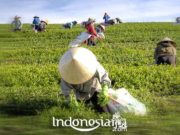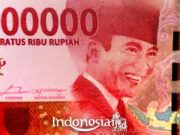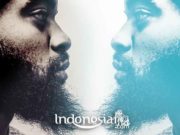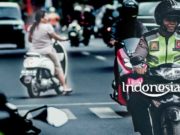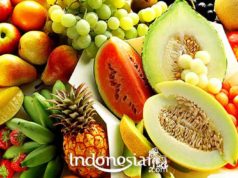The Srivijaya kingdom originated from the eastern coast of Sumatra and has been a busy trade route visited by traders from India from around the beginning of AD. So that began to appear trading centers around there too. Gradually, these trading centers developed into small kingdoms around the 7th century AD.
Some of these small kingdoms include: Tulangbawang, Melayu and Sriwijaya. Among the three kingdoms that succeeded in developing until their heyday was Sriwijaya. Although, Malay had also grown rapidly in Jambi, but was successfully conquered by Sriwijaya.
Location of the Sriwijaya Kingdom
The geographic location of the Srivijaya kingdom is estimated to be in Palembang. However, there are those who argue in Jambi, even outside Indonesia. Even so, the opinion most supported by experts is that the location of the Sriwijaya Kingdom was in Palembang.
There are also those who argue that the Sriwijaya Kingdom is a maritime kingdom and does not have a neat administrative system. They prefer to keep a close eye on their power at sea and pay little attention to the center of government on land.
Thus, this opinion states that this kingdom is a nomadic kingdom (always on the move) and does not have a fixed central government location.
However, until now, the most supported research results show that the center of the Sriwijaya Kingdom is Palembang. It’s just that, when the center of the kingdom experienced a decline, the center of Sriwijaya government moved to Jambi.
Here is a map of the location of the Sriwijaya Kingdom.
The territory of Sriwijaya
Sriwijaya is centered between southern Sumatra, parts of Malaysia, and most of the island of Java. When it was victorious, the territory of the Sriwijaya Kingdom was very wide and even stretched from Cambodia, Thailand, the Malay Peninsula, Sumatra, Java, Kalimantan and Sulawesi.
The above statement is in accordance with the opinion of Saptika (2011, p. 33) who said that Sriwijaya was one of the strong maritime empires on the island of Sumatra and had a lot of influence in the archipelago with territories extending from Cambodia, Thailand, the Malay Peninsula, Sumatra, Java, Kalimantan, and Sulawesi.
Relics of the Sriwijaya Kingdom
One of the historical sources of the Sriwijaya Kingdom are inscriptions that are found around the southern part of Sumatra. In addition, there are also several inscriptions found on the island of Java, even abroad. Here is the explanation.
Sriwijaya Kingdom Inscription
Inscription relics of the Srivijaya Kingdom are written using the Palawa script in Sanskrit. Some of the inscriptions are written in Old Malay. Some of the inscriptions from the Sriwijaya Kingdom are as follows.
Kedukan Bukit inscription
The Kedukan Bukit inscription was found on the banks of the Tatang River, near Palembang. This inscription dates from 605 Saka (683 AD). Its contents, among others, explain that a person named Dapunta Hyang made a holy journey (siddhayatra) by boat. He departed from Minangatamwan with an army of 20,000 personnel.
The Kedukan Bukit inscription was found on the banks of the Tatang River near Palembang. This inscription comes from and even dates from 605 Saka which is equivalent to 683 AD.
Its content explains that a person named Dapunta Hyang is on a holy journey or is called siddhayatra by boat. It is said that he departed from Minangtamwan with an army of 20,000 personnel.
Possibly “Minangtamwan” is “Minanga Tamwan” which means an area located between two large rivers that meet. Poerbatjaraka & Soekmono revealed that Minanga is located in the upper reaches of the Kampar River, precisely at the confluence of the Kampar Kanan and Kampar Kiri rivers.
Poerbatjaraka also said that the word Minangatamwan could be the old name of the Minangkabau. Meanwhile, Buchari argues that Minanga is in the upper reaches of Batang Kuantan.
Talang Tuo Inscription
It was given the name Talang Tuo inscription because it was found in the west of Palembang City in the Talang Tuo area. This inscription dates from 606 Saka or the equivalent of 684 AD. This inscription is Pallawa but in Old Malay.
Its contents mention the construction of a garden called Sriksetra, on the orders of Dapunta Hyang Sri Jayagana, for the prosperity of all beings. Apart from that, there are prayers and wishes that show the nature of Buddhism.
Telaga Batu Inscription
The inscription was found in the Telaga Biru pond (not far from Sabokingking), Palembang City. This inscription is not dated or the year of manufacture is not written. It is estimated that this inscription comes from the same year as the Kota Kapur inscription, which is around 686 AD
It contains curses against anyone who commits a crime and does not follow the Kingdom’s rules or the king’s orders. This inscription also contains data regarding the constitutional arrangement of the Sriwijaya Kingdom.
The Kota Kapur Inscription
The Kota Kapur Inscription was found in the village of Penangan, Mendo Barat, Bangka Island. Date (number) in 608 Saka (656 AD). Coedes (2014: 65) suspects that this inscription stone material was imported from outside, because the type of stone is not found on Bangka Island.
The main content is a request to the gods to maintain the unity of Srivijaya. This inscription also contains curses against those who do evil, do not submit to the king or do not obey the Kingdom will be harmed. Another important explanation is that there is a record of Sriwijaya’s efforts to conquer “the land of Java” which has not yet submitted to the Srivijaya Kingdom.
Karang Berahi Inscription
The Karang Berahi inscription is found in Karang Berahi Village, Jambi. This inscription dates from 608 Saka or the equivalent of 686 AD. Its contents are more or less similar to the Kota Kapur Inscription and Telaga Biru Inscription, which is a curse for those who do not submit to Srivijaya.
Historical Sources of the Sriwijaya Kingdom Outside Indonesia
Apart from the inscriptions found in Indonesia, several other inscriptions were also found outside Indonesia. For example, the Ligor Inscription dated 775 AD was found in Ligor, the Malay Peninsula, and the Nalanda Inscription (no number) was found in East India.
Tanjore inscription (India)
Found in India, in this inscription it is stated that in 1017 his troops attacked the Swarnabhumi kingdom (Sumatra; Sriwijaya). The attack was repeated in 1025, when the king named Sanggramawijayatunggawarman was captured by the Cola troops, but finally Sanggramawijaya was released.
Sri Lankan inscription
Found in Srinlanka and estimated to be from the XII century, the contents state that: Suryanaraya from the Malayupura dynasty was crowned maharaja in Suwarnapura (Sriwijaya). Prince Suryanarayana subdued Manabhramana.
Chinese news about Sriwijaya
Apart from these inscriptions, Chinese news is also an important source of Srivijaya history. For example, news from I-Tsing, who had lived in Sriwijaya.
After sailing for 20 days from Guangzhou, I-Tsing arrived at Fo-tsi (Sriwijaya) in 651 AD. He lived and studied in Sriwijaya for six months. The king of Sriwijaya helped him to get to Melayu and I-Tsing stayed there for two months.
Another Chinese source mentions that in 1156 the king of Srimaharaja sent envoys to China, also in 1178.
The Sung Dynasty Chronicles
In 988 AD, a delegation came from Fo-tsi (Sriwijaya) in China. After living for two years in China, he went to Canton and heard that the country had been attacked by She-po. So, he was forced to stay another year in China. In 992 AD, he sailed back to Campa, but because there was no news about his country, he returned to China and asked for the protection of the Chinese emperor.
Development of the Srivijaya Kingdom
There are several factors that caused this kingdom to develop. These factors are:
1. Geographical location of Palembang City.
In front of the mouth of the Musi river there are islands that can function as protectors, making it ideal for defense and government activities. This location is also an international trade route (mainly from India and China). Large rivers, the role of the sea is also suitable for its inhabitants who already have talent as accomplished sailors.
2. The collapse of the Funan Kingdom in Vietnam.
Cambodia had conquered Funan in Vietnam, thus providing an opportunity for the Srivijaya Kingdom to rapidly develop as a maritime country.
Meanwhile, the general state of politics and government will be explained in the description below.
Sriwijaya Political and Governmental Development
The Sriwijaya kingdom began to develop in the 7th century AD. At the beginning of its development, the king was known as Dapunta Hyang (Kedukan Bukit inscription and talang Tuo). Dapunta Hyang continuously made efforts to expand Sriwijaya’s territory. The following is a sequence of mastery.
1. Tulang-Bawang which is located in Lampung area.
2. Kedah area located on the west coast of the Malay Peninsula. This area is very important for trade development efforts with India. According to I-Tsing, Srivijaya’s conquest of Kedah took place between 682-685 AD.
3. Bangka Island, which is located at the intersection of the international trade road. This area was controlled by Sriwijaya in 686 AD based on the Kota Kapur inscription.
4. Jambi area is located on the banks of the Batanghari River. This area has an important position to facilitate trade on the east coast of Sumatra. This conquest was carried out in 686 AD (Karang Berahi Inscription).
5. The Isthmus of Kra is the isthmus of the northern part of the Malay Peninsula. Srivijaya’s control over the Isthmus of Kra can be seen from the Ligor Inscription which dates back to 775 AD.
6. Kingdom of Kalingga and Ancient Mataram. According to the Chinese news, it was reported that there was an attack from the west, which forced the Kalingga Kingdom to move to the east. It is suspected that it was Sriwijaya who carried out the attack.
All control was based on trade routes which were considered important for developing the maritime economy of the Sriwijaya Kingdom.
Thanks to the expansion of the area, Sriwijaya became a great kingdom. To further strengthen its defense, in 775 AD Srivijaya built a royal base in the Ligor area on the orders of king Darmasetra.
Srivijaya Religious Life
Religious life in Sriwijaya is very strong and vibrant. Sriwijaya even managed to become the center of Mahayana Buddhism in the Southeast Asia region. I-Tsing in his notes tells that thousands of Buddhist students and priests live in Sriwijaya.
One of the famous Buddhist priests is Sakyakirti. Many foreign students who deliberately come to Sriwijaya to study Sanskrit. Between the years 1011-1023 a Buddhist priest from Tibet named Atisa came to deepen his religious knowledge.
Relics of the Srivijaya Kingdom related to the development of religion include:
1. Muara Takus Temple, found near the Kampar River in the Riau area.
2. Buddha statues, found in the Siguntang Hill area.
3. Nagipattana Temple, built by Srivijaya in Nagipattana, South India.
Once upon a time Raja Balaputra awarded a plot of land to Balaputradewa for the establishment of a hostel for students and students currently studying in Nalanda, which is funded by Balaputradewa, as “dharma”.
This is well recorded in the Nalanda inscription, which is currently at the Nawa Nalanda University, India. Even the form of the dormitory has architectural similarities with the Muara Jambi temple, which is currently in Jambi Province.
This indicates that Srivijaya paid attention to science, especially knowledge of Buddhism and Sanskrit for the younger generation. This is also in accordance with the opinion of Prasetya (2010, p. 32) which states that Sriwijaya is a large Buddhist kingdom that has developed a climate conducive to the development of Buddhism.
Economic Life of the Srivijaya Kingdom
Initially, the people of Sriwijaya mostly lived by farming. However, due to Sriwijaya’s location on the banks of the Musi River which was connected to the coast, trade developed rapidly. Then, trade eventually became Sriwijaya’s main livelihood.
The development of this trade was certainly triggered by the strategic geographical location of the Sriwijaya Kingdom. It is right at the crossroads of international trade routes. The Chinese merchants who sailed to India would first stop at Sriwijaya, and vice versa.
Thus, the Sriwijaya Kingdom was increasingly busy and developed into a trade center. This kingdom also began to control national and international trade routes. The Sriwijaya trade route stretches from the Natuna Sea, Malacca Strait, Sunda Strait and Java Sea to Southeast Asia, which is the international trade route between India and China.
Apart from getting direct benefits from trade, Sriwijaya also gained indirect advantages. Ships calling and loading and unloading are required to pay taxes. This certainly adds to the prosperity of this Kingdom.
The cultural products of the Srivijaya kingdom include ivory, skins, several types of wild animals for export purposes. Meanwhile, they tend to import a lot of rice, spices, cinnamon, incense, gold, ivory, and animals.
Genealogy of the Srivijaya Kingdom
1. Dapunta Hyang Sri Jayanaga (683 AD)
It is thought that he was the founder of the Sriwijaya Kingdom, which is mentioned in the Keduka Bukit inscription, Talang Tuo, and Kota Kapur. The king conquered the Malay and Tarumanegara Kingdoms during his reign.
2. Indravarman (702 AD)
Indravarman had sent envoys to China in 702-716 AD and 724M.
3. Rudra Vikraman / Lieou-t`eng-wei-kong (728 AD)
Rudra Vikraman had sent an envoy to China in 728-748M.
4. Dharmasetu (790 AD)
5. Sangramadhananjaya / Wisnu / Vishnu (775 AD)
During his leadership, the King who brought Sriwijaya conquered South Cambodia.
6. Samaratungga (792 AD)
Sriwijaya failed to maintain power in Southern Cambodia in 802 AD.
7. Balaputra Sri Kaluhunan (Balaputradewa) (835M)
The king who brought the Srivijaya Kingdom to its golden age. He also ordered the creation of a monastery for the Cola Kingdom in India and left the Nalanda Inscription.
8. Sri Udayadityawarman (960 AD)
Had sent envoys to China in 960 AD
9. Sri Wuja or Sri Udayadityan (961 AD)
Sent envoys to China in 961-962 AD
10. Hsiae-she (980 AD)
During his reign, King Hsiae-she sent envoys to China in 980-983
11. Sri Cudamaniwarmadewa (988 AD)
When Sriwijaya was under his control, there was an attack from Java.
12. Sri Marawijayottunggawarman (1008 AD)
During his leadership, he sent envoys to China in 1008
13. Sumatrabhumi (1017 AD)
During his reign, King Sumatrabhumi sent envoys to China in 1017
14. Sri Sanggramawijayottunggawarman (1025)
Had been conquered and captured by the Cola Kingdom of India, then released.
15. Sri Deva (1028 AD)
Had sent envoys to China in 1028 AD
16.Dharmavira (1064 AD)
17. Sri Maharaja (1156 AD)
Once sent an envoy to China in 1156 AD
18.Trailokaraja Maulibhusana Varmadeva (1178 AD)
During his reign, he sent envoys to China in 1178 AD
In 1402 the last prince of the Srivijaya Empire, namely Parameswara founded the Malacca Sultanate on the Malaysian Peninsula.
The heyday of the Sriwijaya Kingdom
The most famous name of the king of the Srivijaya kingdom is Balaputradewa. He ruled around the 9th century AD. During his reign, Srivijaya developed rapidly and reached its heyday or golden age.
He succeeded in growing the economy of this kingdom and expanding Sriwijaya’s power to islands outside Indonesia. Balaputradewa is a descendant of the Syailendra Dynasty, namely the son of King Samaratungga and Dewi Tara from Sriwijaya. This is explained in the Nalanda Inscription.
This famous king of the Srivijaya Kingdom (Balaputradewa) was a great king in Sriwijaya. Raja Balaputradewa had a close relationship with the Bengal Kingdom which was then ruled by Raja Dewapala Dewa.
The collapse of the Srivijaya Empire
The decline factor of the Srivijaya Kingdom was influenced by a kingdom that was too dependent on marine trade, a state system that was not well ordered, and the condition of land territory power that was not given enough attention due to being too busy developing maritime affairs.
Some of the decline factors of the Sriwijaya Kingdom (Kemdikbud, 2017, p.109) include:
1. Changing natural conditions around Sriwijaya, no longer close to the beach. This is because the changes in the flow of the Musi, Ogan and Komering rivers carry a lot of mud so that they are not conducive to trade.
2. Many areas of power became independent from Sriwijaya. This is thought to be due to the weakening of the Srivijaya navy, making surveillance more difficult.
3. Srivijaya received attacks from other kingdoms. Primarily, the attack launched by Raja Rajendracola of the Colamandala Kingdom in 1017 AD and 1024 AD Then in 1275 Kartanegara from Singhasari carried out a Pamalayu expedition which caused the Malay area to escape from Sriwijaya’s grasp.
The peak of the collapse of this kingdom was in 1377, when the fleet from the Majapahit Kingdom attacked and succeeded in conquering the Srivijaya Kingdom.
Source : serupa





